Arrival at Incheon International Airport, and meet the driver. Transfer to Seoul hotel.
The balance of the day is at your leisure.
Overnight at: Lotte Hotel Seoul - Grand Deluxe room
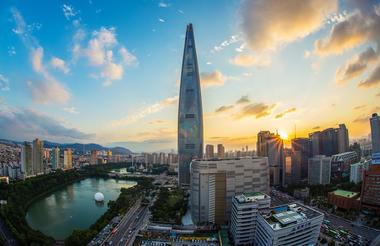
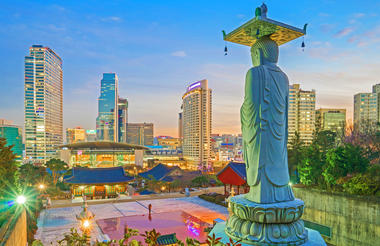
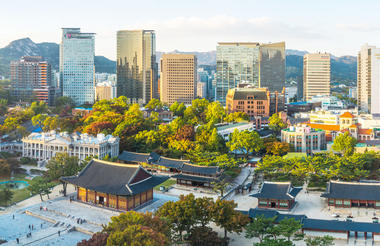
You will meet your English-Speaking guide at the hotel lobby at 09:00 AM to start the tour.
Gyeongbokgung Palace *closed on Tuesdays*
Built in 1395, Gyeongbokgung Palace is also commonly referred to as the Northern Palace because its location is furthest north when compared to the neighboring palaces of Changdeokgung (Eastern Palace) and Gyeonghuigung (Western Palace) Palace. Gyeongbokgung Palace is arguably the most beautiful, and remains the largest of all five palaces.
Hanbok Wearing Experience
Hanbok is the traditional attire of the Korean people. Worn daily up until just 100 years ago, hanbok comes in various shapes and colors, reflecting the culture and lifestyle of its time. Nowadays, it is only worn on special occasions or anniversaries. It is a formal wear and many Koreans keep a hanbok for such occasions.
Insadong Alley
Insa-dong, located in the heart of the city, is an important place where old but precious traditional goods are on display. There is one main road in Insa-dong with alleys on each side. Within these alleys are galleries, traditional restaurants, teahouses, and cafes.
N Seoul Tower
The N Seoul Tower, officially the YTN Seoul Tower and commonly known as Namsan Tower or Seoul Tower, is a communication and observation tower located on Namsan Mountain in central Seoul, South Korea. The 236-meter-tall tower marks the second highest point in Seoul.
Namsangol Hanok Village
Namsangol Hanok Village is an ancient village from Joseon period (1392-1910), located on the northern side of Namsan Mountain. It was opened to the public with free admission in 1998. Namsangol Hanok Village was known for its five hanoks (traditional Korean houses) from Joseon Dynasty that were located in various parts of the city until the City of Seoul moved and restored them here.
Overnight at: Lotte Hotel Seoul - Grand Deluxe room
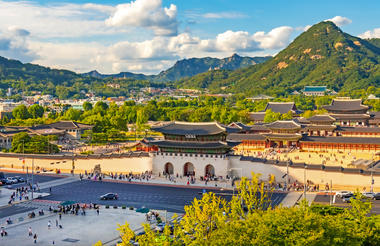
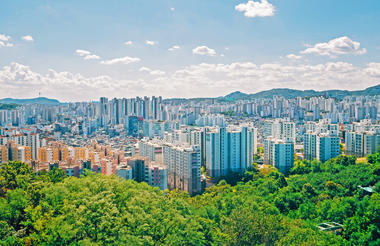
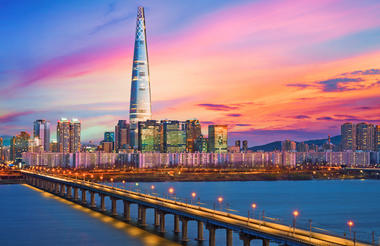
You will meet your English-Speaking guide at the hotel lobby at 06:00 AM to start the tour.
DMZ Tour(Passport REQUIRED)
The DMZ tour shows why Seoul is the only place in the world where the Cold War still physically manifests. It is a must-visit for history buffs, political enthusiasts, and curious travelers alike. This tour offers an educational experience, heartbreaking memories of the Korean War's legacy, and unique sights that cannot be seen anywhere else on Earth.
Transfer to the hotel and rest.
Overnight at: Lotte Hotel Seoul - Grand Deluxe room

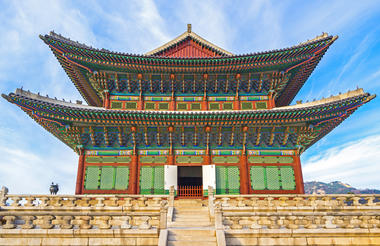
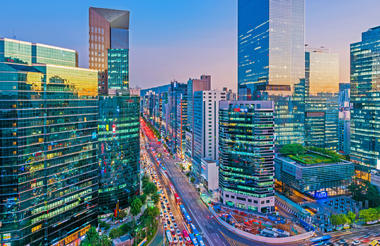
You will meet your driver at the hotel lobby (TBD, based on domestic flight) and escort you to Gimpo Airport. At Jeju, you will meet your English-Speaking local guide and start the tour.
Hallim Park
Jeju Hallim Park is a field of frontier spirit of a man who transformed a wasteland to a green paradise. Nine different theme gardens and seasonal festivals, Hallim park is an international tourist attraction of Jeju island, South Korea exhibiting global species of plants and animals. It is 80 acre big and has nearly 1.2 million visitors every year.
O’Sulloc Tea Museum
O'Sulloc Tea Museum, located next to O'sulloc's Seogwang Tea Planation in Jeju, was opened by Amore Pacific in 2001 with the aim of introducing and spreading Korean teas and the traditional tea culture of Korea. The museum is a cultural space where the West and the East, and modernity and tradition coexist in harmony.
Overnight at: Grand Josun Jeju - Deluxe Twin

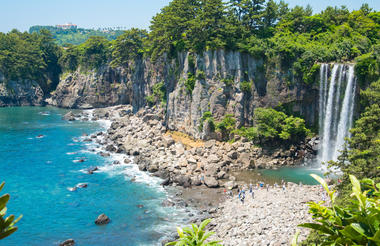
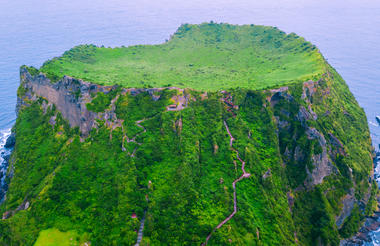
You will meet your English-Speaking guide at the hotel lobby at 09:00 AM to start the tour.
Seongsan Ilchulbong
Seongsan Ilchulbong Tuff Cone rose 180 meters above sea level due to a magma flow under the sea over 5,000 years ago. It was originally a separate island, but a build-up of sand and soil has connected it to the main island. A large crater, formed by the hot lava mixing with cold ocean water, is located at the top of Seongsan Ilchulbong Tuff Cone. It has been featured in films, and was originally used for agriculture, but has now been given over to a field of silver grass. *Closed on the first Monday of every month
Seopjikoji
Seopjikoji gets its name from its shape, jutting out to sea, with 'koji' being the Jeju dialect for a cape. Located just south of Seongsan Ilchulbong Tuff Cone, the cape is a popular tourist attraction. The tuff cone along with a beautiful vista of the ocean and fields of canola flowers can easily be seen from the peak of Seopjikoji. On top of the hill stands a beacon fire station built using volcanic rocks. Behind the beacon fire station is Bulgeunoreum Volcanic Cone, vibrant with red soil. The white lighthouse atop the cone stands out in contrast.
Jeju Folk Village
Jeju Folk Village has comprehensively organized Jeju’s traditional folklore materials by setting 1890, the end of the Joseon Dynasty, as its base year and has put them on display for all to see. It is a place where Jeju’s folk culture is properly preserved, where people can see trees and flowers in a single glance.
U-do Island
U-do Island is an island in Jeju Province, South Korea. The island is one of Jeju's most popular destinations, with 2.23 million visitors in 2016. It is known for its scenic beaches, sheer rocky cliffs, and sea caves. It is reachable by ferry, and bikes and public transit are available on the island.
Overnight at: Grand Josun Jeju - Deluxe Twin
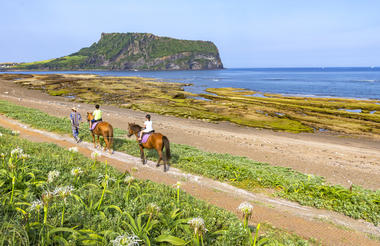
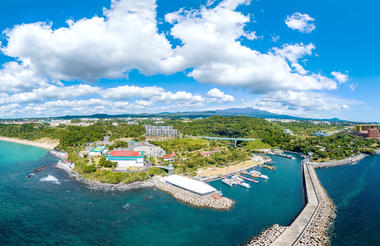
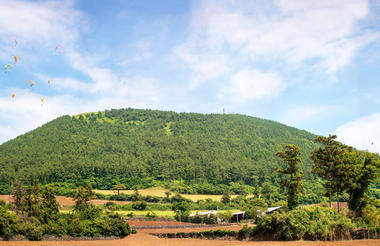
You will meet your English-Speaking guide at the hotel lobby at 09:00 AM to start the tour.
Sanbangsan
Sanbangsan Mountain is a trachytic tuff lava dome connected to the sedimentary layer of the Yongmeori Coast in the coast of Sagye-ri, Andeok-myeon. It is a bell-shaped tholoid that stands tall in the plains of southwest Jeju, allowing it to be seen from anywhere in the area.
Sanbangsan Cruise
Hop aboard a one-hour jaunt over the waters of Jeju Island to see the UNESCO listed Jeju Global Geopark Sanbangsan! This fascinating geological area is a protected area. From your cruise, you'll not only be able to marvel at the lushness of this protected area, but you'll also be able to see the Songaksan Volcano.
Cheonjeyeon Waterfall
The wooded area around the falls is home to the wild dampalsu trees, designated as Natural Monument, as well as a great variety of rare plants such as brambles, and songyeopnan as well as gusiljappam trees, sanyuja trees (Chinese lemon trees), and camellias. Altogether, this forest is designated as Natural Monument.
Daepo Jusangjeoli
Jusangjeolli are stone pillars piled up along the coast and is a designated cultural monument. Jusangjeolli Cliff was formed when the lava from Hallasan Mountain erupted into the sea of Jungmun.
Camelia Hill
Located in Sangchang Village, Andeok-myeon, the 20-hectare park holds some 6,000 camellia trees and over 500 different species of wildflowers, trees and other plants, like hydrangeas. It’s about an hour by bus to the southwest of Jeju City.
Overnight at: Grand Josun Jeju - Deluxe Twin
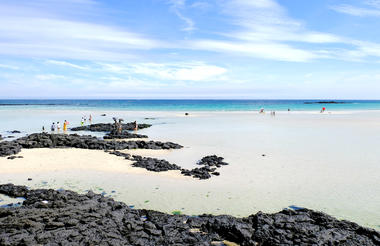
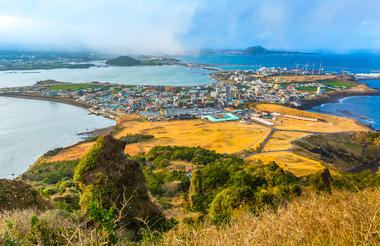
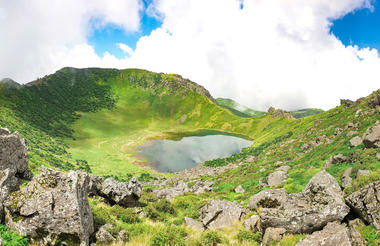
You will meet your driver at the hotel lobby (TBD, based on domestic flight) and escort you to Jeju Airport for a flight to Busan.
After transferring to Busan by domestic air, you will meet your English-Speaking local guide and start the tour.
Ahopsansup Forest
Ahopsan Forest spreads over 520,000 ㎡ and is comprised of 400-year-old trees. It’s a great place to see bamboo, pine trees, ginkgo trees, azaleas and more in a pristine state. The forest has stood as a greenbelt for a long time, serving as a protection area of source water.
Haedong Yonggungsa Temple
This superb attraction offers visitors the rare find of a temple along the shoreline; most temples in Korea are located in the mountains. Haedong Yonggungsa Temple was first built in 1376 by the great Buddhist teacher known as Naong during the Goryeo dynasty. Haesu Gwaneum Daebul (Seawater Great Goddess Buddha), Daeungjeon Main Sanctuary, Yongwangdang Shrine, Gulbeop Buddhist Sanctum (enclosed in a cave), and a three-story pagoda with four lions can all be seen looking out over the ocean.
Overnight at: Signiel Busan - Signiel Premier Twin Ocean Mipoharbor view
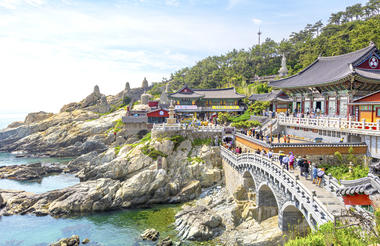
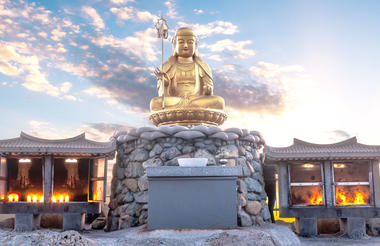
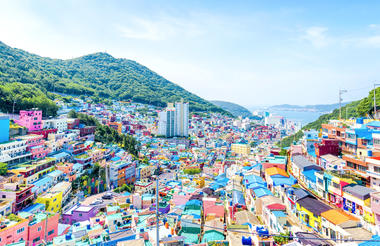
You will meet your English-Speaking guide at the hotel lobby at 09:00 AM to start the tour.
Taejongdae Cliff
Taejongdae Cliffed Coast was formed by many layers of rock being forced together beneath a lake during the Cretaceous period, and then worn away over time by the sea. Visitors can enjoy walking on the forested paths, or take the train course to easily access Taejongdae Observatory and Yeongdo Coastal Culture Space.
Hyuninyeoul Culture Village
Above the steep wall of the Jeoryeong Coastal Trail is a unique view of the village, where you can see small houses clustered along the narrow alley formed by the coast at the end of the cliff. Huinnyeoul-gil, the representative original downtown center of Busan, was named after the current of water at the foot of the Bongnaesan Mountain that resembles the white falling snow.
Jagalchi Market
Jagalchi Market, located on the seaside road in Busan's Jung-gu, is Korea's largest seafood market, selling both live and dried fish. Most of the people who sell fish are women, so the vendors here are called Jagalchi Ajumma, "ajumma" meaning middle-aged or married woman in Korean. Visitors can eat fresh raw fish right at the market. *Closed on the 1st and 3rd Tuesday of every month
Gukje Market
Following the Korean War, refugees who fled to Busan set up stalls in order to make a living by selling smuggled or imported products, which developed into Gukje Market. Gukje Market is one of Korea’s largest markets. The market's alleyways are lined with stalls selling diverse goods, particularly machinery tools, kitchenware, and clothing.*Closed on Sundays
Overnight at: Signiel Busan - Signiel Premier Twin Ocean Mipoharbor view

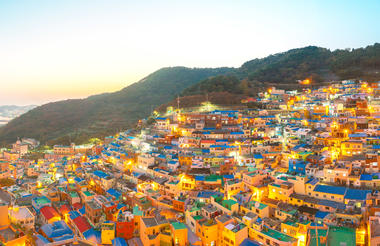
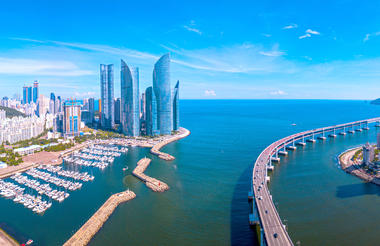
You will meet your English-Speaking guide at the hotel lobby at 09:00 AM to start the tour and will be transferred to
Seokguram Grotto
A hermitage and part of the Bulguksa temple complex. It is classified as National Treasure No. 24 by the South Korean government. It exemplifies some of the best Buddhist sculptures in the world.
Bulguksa Temple
It is located on the slopes of Mount Toham. It is a head temple of the Jogye Order of Korean Buddhism and encompasses seven National treasures of South Korea, including the Dabotap and Seokgatap stone pagodas, Cheongun-gyo (Blue Cloud Bridge), and two gilt-bronze statues of Buddha. The temple is classified as Historic and Scenic Site No. 1 by the South Korean government.
Cheomseongdae Observatory
Cheomseongdae Observatory, constructed during the reign of Queen Seondeok (r. 632-647), is one of the landmark of Gyeongju. The observatory was built in a cylinder shape and consists of 365 stones, symbolizing the number of days in a year. The rocks are piled in 27 layers symbolizing the 27th ruler, Queen Seondeok, and the days in a lunar month by adding the of two rock layers on top.
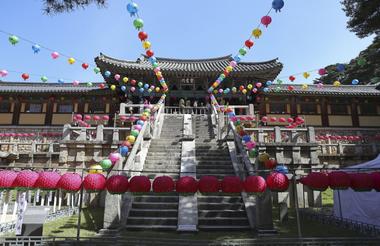
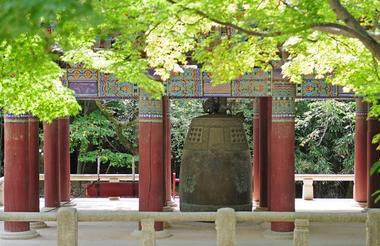
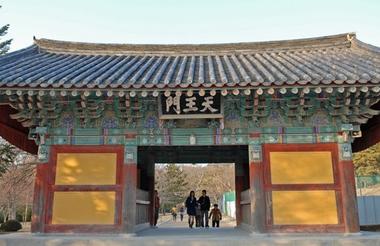
You will meet your driver at the hotel lobby and will be transferred to Gimhae Airport.





